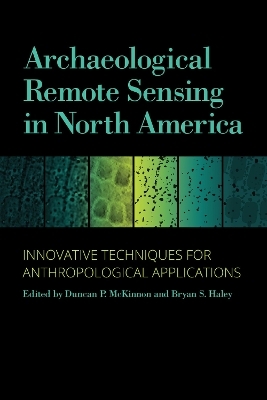
Archaeological Remote Sensing in North America
Innovative Techniques for Anthropological Applications
Seiten
2017
The University of Alabama Press (Verlag)
978-0-8173-1959-5 (ISBN)
The University of Alabama Press (Verlag)
978-0-8173-1959-5 (ISBN)
- Titel z.Zt. nicht lieferbar
- Versandkostenfrei
- Auch auf Rechnung
- Artikel merken
Presents the latest on the rapidly growing use of innovative archaeological remote sensing for anthropological applications in North America. Updating the highly praised 2006 publication Remote Sensing in Archaeology, this is a must-have volume for today's archaeologist.
The latest on the rapidly growing use of innovative archaeological remote sensing for anthropological applications in North America. Updating the highly praised 2006 publication Remote Sensing in Archaeology , edited by Jay K. Johnson, Archaeological Remote Sensing in North America: Innovative Techniques for Anthropological Applications is a must-have volume for today's archaeologist. Targeted to practitioners of archaeological remote sensing as well as students, this suite of current and exemplary applications adheres to high standards for methodology, processing, presentation, and interpretation. The use of remote sensing technologies to address academic and applied archaeological and anthropological research problems is growing at a tremendous rate in North America. Fueling this growth are new research paradigms using innovative instrumentation technologies and broader-area data collection methods. Increasingly, investigators pursuing these new approaches are integrating remote sensing data collection with theory-based interpretations to address anthropological questions within larger research programs. In this indispensable volume, case studies from around the country demonstrate the technically diverse and major remote sensing methods and their integration with relevant technologies, such as geographic information systems (GIS) and global positioning systems (GPS), and include various uses of the �big four�: magnetometry, resistivity, ground-penetrating radar (GPR), and electromagnetic induction. The study explores four major anthropological themes: site structure and community organization; technological transformation and economic change; archaeological landscapes; and earthen mound construction and composition. Concluding commentary from renowned expert Kenneth L. Kvamme overviews the practices, advances, and trends of geophysics and remote sensing in the past decade.
The latest on the rapidly growing use of innovative archaeological remote sensing for anthropological applications in North America. Updating the highly praised 2006 publication Remote Sensing in Archaeology , edited by Jay K. Johnson, Archaeological Remote Sensing in North America: Innovative Techniques for Anthropological Applications is a must-have volume for today's archaeologist. Targeted to practitioners of archaeological remote sensing as well as students, this suite of current and exemplary applications adheres to high standards for methodology, processing, presentation, and interpretation. The use of remote sensing technologies to address academic and applied archaeological and anthropological research problems is growing at a tremendous rate in North America. Fueling this growth are new research paradigms using innovative instrumentation technologies and broader-area data collection methods. Increasingly, investigators pursuing these new approaches are integrating remote sensing data collection with theory-based interpretations to address anthropological questions within larger research programs. In this indispensable volume, case studies from around the country demonstrate the technically diverse and major remote sensing methods and their integration with relevant technologies, such as geographic information systems (GIS) and global positioning systems (GPS), and include various uses of the �big four�: magnetometry, resistivity, ground-penetrating radar (GPR), and electromagnetic induction. The study explores four major anthropological themes: site structure and community organization; technological transformation and economic change; archaeological landscapes; and earthen mound construction and composition. Concluding commentary from renowned expert Kenneth L. Kvamme overviews the practices, advances, and trends of geophysics and remote sensing in the past decade.
Duncan P. McKinnon is an assistant professor of anthropology at the University of Central Arkansas and a research associate at the Center for American Archeology. He has published in American Antiquity, Southeastern Archaeology, Arkansas Archeologist,MidcontinentalJournal of Archaeology and Caddo Journal. Bryan S. Haley is an archaeologist and terrestrial/marine remote sensing specialist in the New Orleans Office of Coastal Environments, Inc. He specializes in prehistoric and historic Native archaeology in the southeastern United States. His sixteen years of remote sensing experience includes work on projects in twenty-three American states, Central America, South America, and Europe.
| Erscheinungsdatum | 18.11.2017 |
|---|---|
| Co-Autor | Rory Becker, Daniel P. Bigman, Jane E. Buikstra |
| Zusatzinfo | 71 black & white figures |
| Verlagsort | Alabama |
| Sprache | englisch |
| Maße | 152 x 229 mm |
| Gewicht | 620 g |
| Themenwelt | Geisteswissenschaften ► Archäologie |
| Naturwissenschaften ► Geowissenschaften ► Geografie / Kartografie | |
| Sozialwissenschaften ► Ethnologie ► Völkerkunde (Naturvölker) | |
| Sozialwissenschaften ► Soziologie | |
| Technik | |
| ISBN-10 | 0-8173-1959-X / 081731959X |
| ISBN-13 | 978-0-8173-1959-5 / 9780817319595 |
| Zustand | Neuware |
| Haben Sie eine Frage zum Produkt? |
Mehr entdecken
aus dem Bereich
aus dem Bereich
über eine faszinierende Welt zwischen Wasser und Land und warum sie …
Buch | Hardcover (2023)
dtv (Verlag)
CHF 33,55
Buch | Hardcover (2024)
Schweizerbart'sche, E. (Verlag)
CHF 33,55
Eine Einführung in die spezielle Mineralogie, Petrologie und …
Buch | Hardcover (2022)
Springer Spektrum (Verlag)
CHF 83,95


